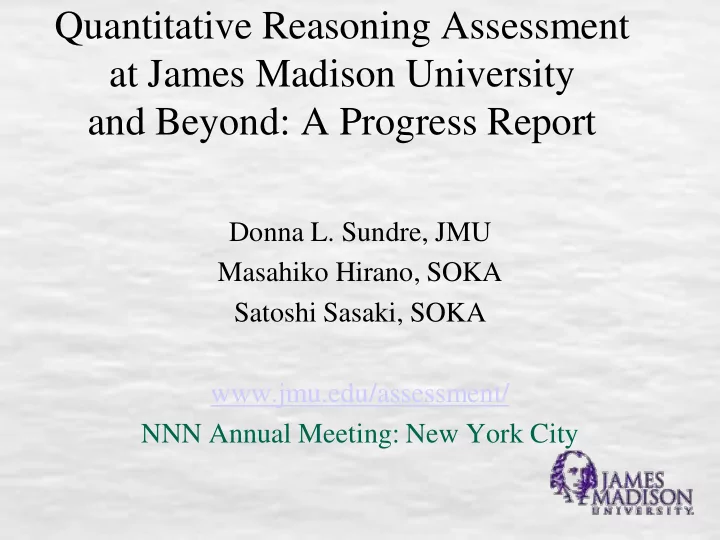

Quantitative Reasoning Assessment at James Madison University and Beyond: A Progress Report Donna L. Sundre, JMU Masahiko Hirano, SOKA Satoshi Sasaki, SOKA www.jmu.edu/assessment/ NNN Annual Meeting: New York City
Quantitative Reasoning Test (QR-9): Turning Japanese…….
General Education: Assessment of Scientific and Quantitative Reasoning • These are among the skills most valued by employers • What could be more important than Quantitative Reasoning? • These are thinking skills, not math computation skills • We want these skills to last a life time • We had the opportunity to partner with Soka University in Japan
Our Collaboration Results: • All measures converted to metric • A data collection design for SOKA • Placement of test on web server • Review and pilot of test by SOKA faculty • Successful administration of test to students • Comparisons of results for several samples
QR Goes Metric Conversations with Soka University-Tokyo, Japan Conversion of items to metric scalars Miles to Kilometers Pounds to Kilograms Inches to Centimeters “Miles per gallon” to “Kilometers per liter” Thought about a full translation to Japanese
Results from our Studies Three student samples Soka University: N=26 Honors Students Global Citizenship Program: 14 First-year; 12 Sophomores JMU: N=1,072 Sophomore/Juniors Random sample from Spring 2012 Assessment Day JMU: N=219 Senior STEM Majors Physics, Chemistry, Biology & Psychology
Student Learning Objectives This is the Engine that drives assessment QR Learning Objectives: 1. Use graphical, symbolic, and numerical methods to analyze, organize, and interpret natural phenomenon. 2. Discriminate between association and causation, and identify the types of evidence used to establish causation.
Soka University Honors Students Items Assessing Learning Objectives Scores Objective 5. Use graphical, symbolic, and M = 15.12 (72% correct) numerical methods to analyze, 2-13, 18-26 SD = 1.90 (21 items) organize, and interpret natural phenomenon. 6. Discriminate between association M = 5.88 (59% correct) and causation, and identify the types 1, 14-17, 20, 23-26 SD = 1.51 (10 items) of evidence used to establish causation 1-26 M = 18.62 (72% correct) (26 items) Quantitative Reasoning SD = 2.52
JMU Sophomores/Juniors Items Assessing Learning Objectives Scores Objective 5. Use graphical, symbolic, and M = 13.68 (65% correct) numerical methods to analyze, 2-13, 18-26 SD = 3.08 (21 items) organize, and interpret natural phenomenon. 6. Discriminate between association M = 6.13 (61% correct) and causation, and identify the types 1, 14-17, 20, 23-26 SD = 1.88 (10 items) of evidence used to establish causation M = 17.59 (68% correct) 1-26 Quantitative Reasoning SD = 3.74 (26 items)
JMU Seniors Items Assessing Learning Objectives Scores Objective 5. Use graphical, symbolic, and M = 15.32 (73% correct) numerical methods to analyze, 2-13, 18-26 SD = 2.69 (21 items) organize, and interpret natural phenomenon. 6. Discriminate between association M = 7.03 (70% correct) and causation, and identify the types 1, 14-17, 20, 23-26 SD = 1.76 (10 items) of evidence used to establish causation 1-26 M = 19.59 (75% correct) (26 items) Quantitative Reasoning SD = 3.09
QR-9 Scores for Soka University and JMU Students 80 70 60 Percent Correct Score 50 Soka 40 JMU Sophomore / Junior JMU Senior 30 20 10 0 Subscale 5 Subscale 6 Total Subscale
Conclusions The Soka students performed brilliantly The QR Test operated effectively in Japan JMU seniors score a little bit higher than our sophomores — and slightly higher than Soka Honors students We see similar patterns in scores with students scoring slightly lower on Objective 6-discrimination between correlation and causation We are exploring this finding at JMU with faculty
Questions? Comments? The QR and SR instruments are available at Madisonassessment.com Center for Assessment and Research Studies James Madison University www.jmu.edu/assessment/
Recommend
More recommend